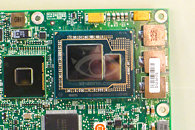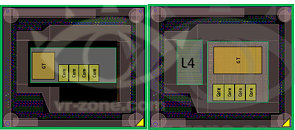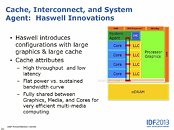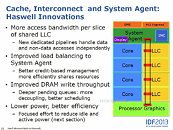Tuesday, April 16th 2013

Intel Readies Haswell Variants with Large Graphics Cores, and eDRAM Caches
To tackle upcoming generations of Ultrabooks and NUC that lack space for discrete graphics, yet having to keep up with the demands of higher display resolutions (i.e. proliferation of 3840 x 2160), Intel is designing special variants of its Core "Haswell" processors that feature large integrated graphics cores bolstered by fourth-level eDRAM caches on-package. Pictured below, is one such contraption.
The graphics-enhanced Core "Haswell" processor is an MCM (multi-chip module) of two dies, the larger one is the actual "Haswell" processor complex with cores, uncore, and the larger GT3 integrated graphics core. While the standard Haswell silicon with GT1 and GT2 integrated GPU options, physically features up to 20 execution units (EUs), the large GT3 silicon features double that, at 40 EUs.The first slide below details the Haswell GT3 package, while the second one details a standard Core "Haswell" implementation. You'll notice that apart from a larger graphics core, the processor features an additional stop on its ring-bus, the eDRAM PHY, interfacing with an external eDRAM silicon (the smaller chip on the MCM). Treated as L4 cache, the eDRAM chip provides higher bandwidth and lower latency than the main memory, for the graphics core to temporarily hold whatever it's working on, without clogging the main memory bus much. This is similar in principle to AMD's Sideport Memory, use of small amounts of faster memory on the motherboard to boost integrated graphics performance.Haswell GT3 is being designed to offer graphics performance that rivals discrete GPUs from NVIDIA and AMD under the 20W TDP envelope. Haswell GT3 (the entire package) itself features a TDP of 55W, which may seem high for Ultrabooks, but are backed by power management features that work to reduce the net power draw. Intel believes Haswell GT3 could provide a viable alternative to standard Haswell silicon aided by discrete GPUs.
Source:
VR-Zone
The graphics-enhanced Core "Haswell" processor is an MCM (multi-chip module) of two dies, the larger one is the actual "Haswell" processor complex with cores, uncore, and the larger GT3 integrated graphics core. While the standard Haswell silicon with GT1 and GT2 integrated GPU options, physically features up to 20 execution units (EUs), the large GT3 silicon features double that, at 40 EUs.The first slide below details the Haswell GT3 package, while the second one details a standard Core "Haswell" implementation. You'll notice that apart from a larger graphics core, the processor features an additional stop on its ring-bus, the eDRAM PHY, interfacing with an external eDRAM silicon (the smaller chip on the MCM). Treated as L4 cache, the eDRAM chip provides higher bandwidth and lower latency than the main memory, for the graphics core to temporarily hold whatever it's working on, without clogging the main memory bus much. This is similar in principle to AMD's Sideport Memory, use of small amounts of faster memory on the motherboard to boost integrated graphics performance.Haswell GT3 is being designed to offer graphics performance that rivals discrete GPUs from NVIDIA and AMD under the 20W TDP envelope. Haswell GT3 (the entire package) itself features a TDP of 55W, which may seem high for Ultrabooks, but are backed by power management features that work to reduce the net power draw. Intel believes Haswell GT3 could provide a viable alternative to standard Haswell silicon aided by discrete GPUs.




11 Comments on Intel Readies Haswell Variants with Large Graphics Cores, and eDRAM Caches
I mean, it would be awesome to have GT3e as an option for the 13" rMPB, but I honestly dont see how would such a small laptop be able to keep it cool with a 55 TDP.
I currently have an ASUS G1S with a 35 watt TDP CPU & a Geforce 8600M GT and trust me, next laptop I get HAS to be cooler than this BBQ machine.
i know that generation of laptop too well ^^
got myself a c2d with tdp of 35 and an X1900M GPU which cooks your hand and eats battery..
i could have changed it for an 8600GT or 8400GS but i went with my HD4650 (mxm modules)
Just use a copper block, an not some "tin"-can fins with a radial whiner!
mmc module anyone? ah good old days with p1 with mmx, 166Mhz on mmc-1 module looks the same :-P